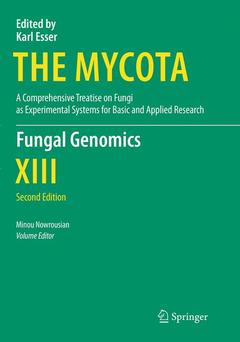Description
Fungal Genomics (2nd Ed., 2nd ed. 2014)
The Mycota Series, Vol. 13
Coordinator: Nowrousian Minou
Language: English
Subjects for Fungal Genomics:
Publication date: 08-2016
Support: Print on demand
Publication date: 04-2014
383 p. · 17.8x25.4 cm · Hardback
Description
/li>Contents
/li>Comment
/li>
The volume is divided into four sections, the first of which, Genome Sequences and Beyond, illustrates the impact of genome-based information and techniques on research ranging from model organisms like yeast to less-studied basal fungal lineages. Furthermore, it highlights novel types of analysis made possible by multi-genome comparisons as well as the impact of genomics on culture collections and vice versa. The second section, Cell and Developmental Biology, addresses questions that are important for fungal biology, e.g. the development of fungal fruiting bodies, and biology in general, e.g. chromatin organization and circadian rhythms. The third section, Genomics for Biotechnology, covers the search for plant biomass-converting enzymes in fungal genomes and work with industrially important fungi. The fourth section, focusing on Pathogenicity, offers chapters on the genomic analysis of plant and animal/human pathogens. It illustrates how genomics at all levels, from genome to metabolome, is used to study mechanisms of the interactions of fungi with other organisms.
Yeast as a model for systems biology studies on complex diseases.- Genomics to study basal lineage fungal biology: phylogenomics suggest a common origin.- Phylogenomics to study fungal biology.- Genome data drives change at culture collections.- Fungal chromatin and its role in regulation of gene expression.- Photobiology and circadian clocks in Neurospora.- Genomics and transcriptomics to analyze fruiting body development.- Degradation and modification of plant biomass by fungi.- Transcriptomics of industrial filamentous fungi: a new view on regulation, physiology and application.- Genomics analysis of biocontrol species and industrial enzyme producers from the genus Trichoderma.- Application of genomics to the study of pathogenicity and development in Fusarium.- Metabolomics and proteomics to dissect fungal phytopathogenicity.- Functional genomics to characterize opportunistic pathogens.- Integration of metabolism with virulence in Candida albicans.
These books may interest you

Genetics and Biotechnology 189.89 €

Genetics and Biotechnology 147.69 €

The Ecological Genomics of Fungi 213.22 €

